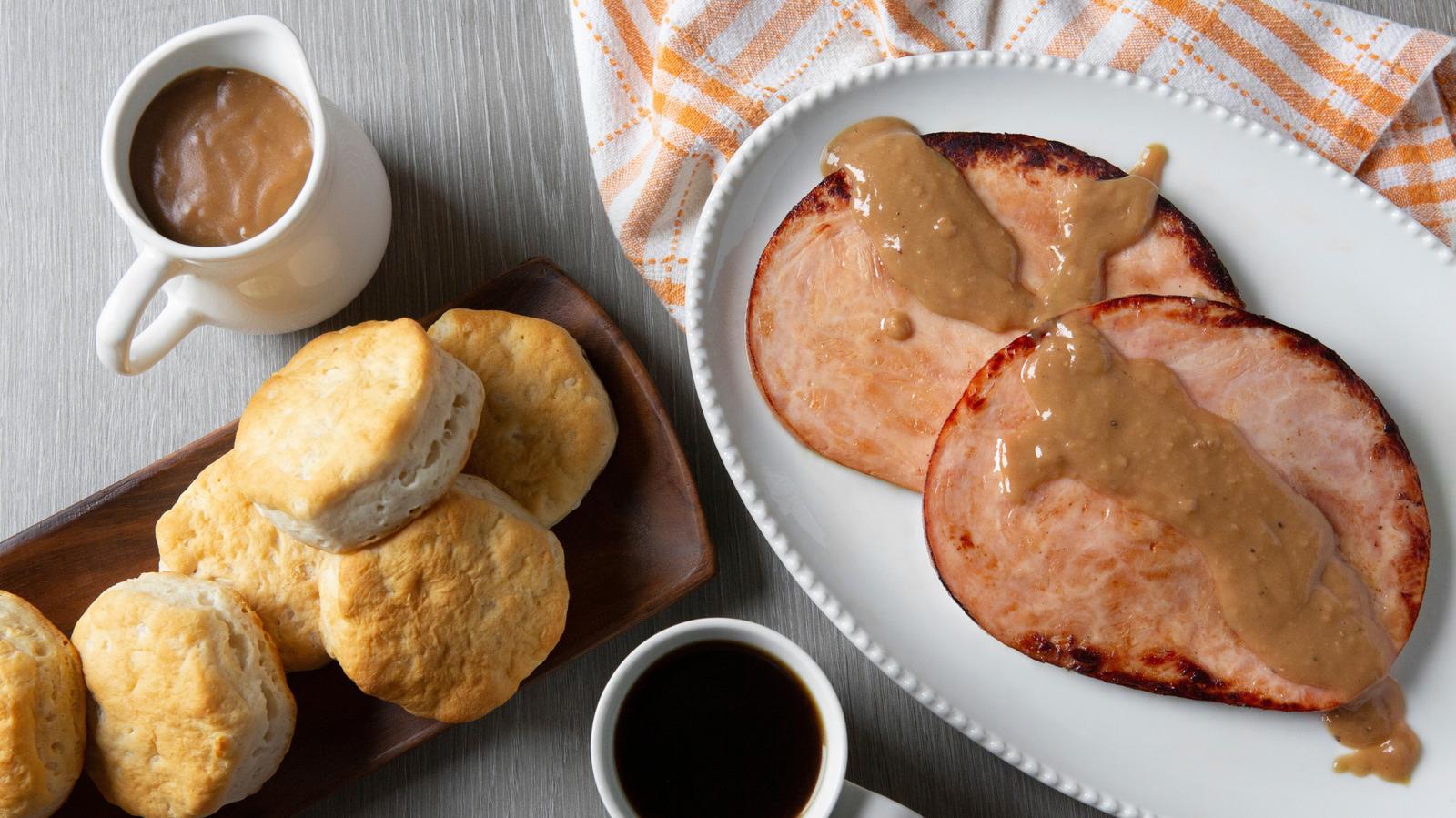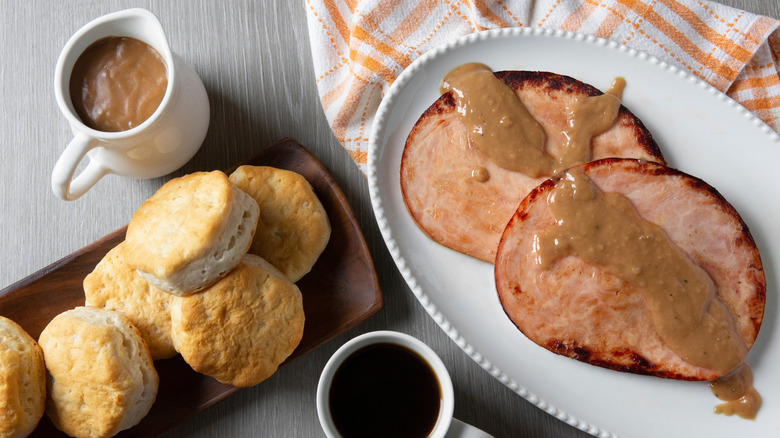
Catherine Murray/Shutterstock
Some Southern foods, like biscuits and gravy, or fried green tomatoes, get all the love. But there are lots of forgotten recipes, too. We're interested in those old-school Southern foods that deserve a revival — the kinds of dishes that your grandparents might have eaten as kids, but that have been rarely seen since. They're not foods you're likely to see on a cute brunch menu or at a local diner, but they should be.
From savory dishes, like spoonbread and hoppin' John, to sweet treats, like Lane cake and chess pie, there's something here to interest most keen cooks, and all keen eaters. Whether you're looking for full recipes to try or are simply interested in forgotten Southern snacks or ingredients, there's plenty to choose from among these 16 old-school Southern foods that we'd love to see more of. Read on to brush up on your food history, and maybe find something new to make for dinner.
Spoonbread
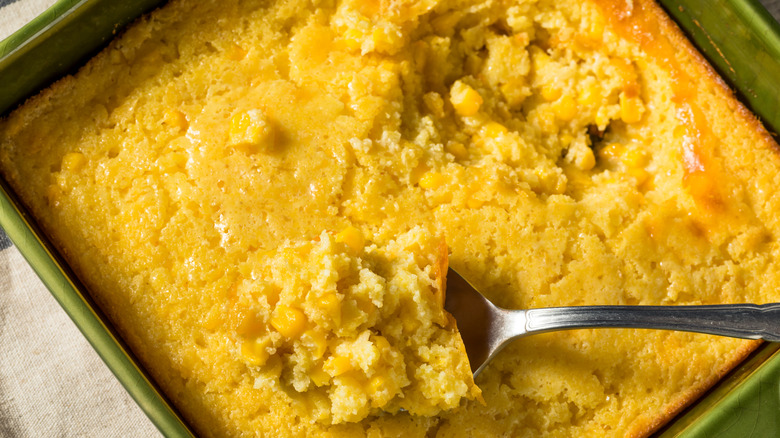
Bhofack2/Getty Images
Spoonbread is similar to cornbread, as it uses many of the same ingredients, but it's not the same thing. The difference is in the texture. Cornbread is sliceable but can be dry and crumbly. Spoonbread, on the other hand, is much more moist, with an almost pudding-like texture. It isn't sliceable but is instead spooned onto your dinner plate, hence the name.
If you're interested in trying it for yourself, give this simple Southern spoonbread recipe a shot. It calls for the ingredients (including cornmeal, milk, eggs, and butter) to be heated together before being thrown into an oven dish, and baked. It's easy to make, and is great served with other Southern dishes like fried chicken, black-eyed peas, and collard greens.
The old-fashioned dish was first referenced in cookbooks in the 1840s, but is likely much older, with origins in Native American communities. If you like cornbread but often find it dry, this is the perfect alternative. Although it isn't popular these days, we think it's time for a comeback.
Hoppin' John

Brent Hofacker/Shutterstock
Hoppin' John is a Southern dish traditionally served to welcome a new year, particularly in the Carolinas. In its current form, it dates back to at least the 1840s, when it appeared in a cookbook called "The Carolina Housewife". However, it's likely much older, and was probably brought to the U.S. through the culinary traditions of enslaved Africans.
When eaten on New Year's Day, it's said to bring luck and prosperity. Some incorporate traditions such as hiding a dime in the food; whoever gets the dime in their portion will, according to the game, have wealth come their way in the year ahead.
There are many variations on Hoppin' John, but the dish traditionally contains rice, black-eyed peas, and some kind of pork or sausage. Some recipes call for cooking everything together, while others cook the ingredients separately, and combine them later. Our Hoppin' John recipe is a simple one, made in a pressure cooker to cut down on time spent cooking the beans. However you make it, you'll likely agree that it's worth pulling out more often than once per year.
Red-eye gravy
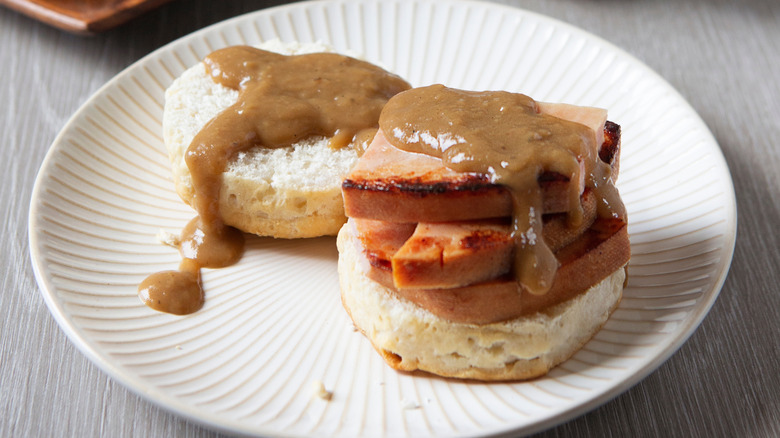
Catherine Murray/Shutterstock
Have you ever thought your gravy could do with a bit more pep? If so, try red-eye gravy, an old-school Southern classic made with black coffee. It might sound strange, but it's an old classic for a reason.
A simple red-eye gravy recipe uses the drippings from frying a slice of country ham, and some strong black coffee. The coffee is added to the drippings, and cooked for a few minutes to reduce the liquid. Some recipes call for some sugar to balance out the flavor, whereas others instruct you to add many more ingredients, so you end up somewhere between a classic mushroom gravy or country gravy, and a standard red-eye gravy.
Red-eye gravy has a deep richness to it from the coffee, and a bold savory note from the ham. You can also make vegetarian versions with butter, and vegan versions with olive oil. It's often served with ham, but it's great with all kinds of protein, or sopped up with fluffy biscuits.
Country Captain
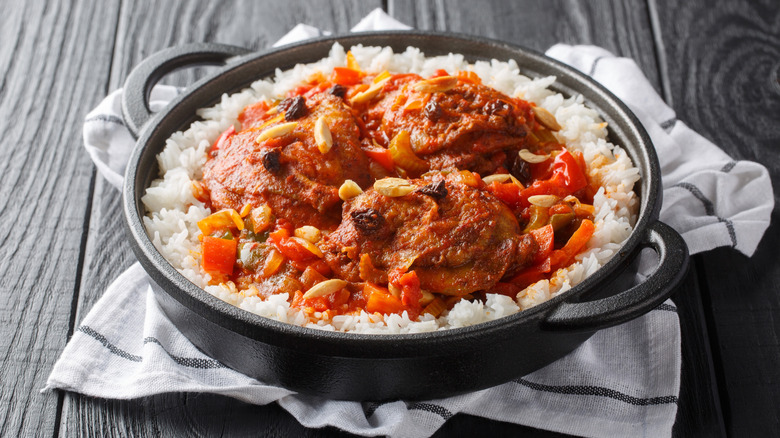
Sergii Koval/Shutterstock
You might not guess it from the name, but Country Captain is a curried chicken dish. It has its roots way back in the 1800s, but has withstood the test of time. It hasn't completely disappeared, but it's no longer the popular dish it once was. We think that deserves to change.
This Southern Lowcountry dish is said to have been a favorite of Franklin D. Roosevelt. Nobody is certain of its origins, but rumor has it, it came to the U.S. by way of a British sea captain, and that's how it got its name. This certainly explains the inclusion of Indian spices, as the country was a British colony at the time.
The dish is effectively chicken on the bone that's served in a curried tomato sauce with currants, and slivers of almonds. The curry sauce is simple, using a commercial curry powder blend to flavor it. The inclusion of celery, bell peppers, and bacon gives it a bit of Southern flair.
Pimento cheese

Alizah Smith/Shutterstock
A classic Southern dish, pimento cheese is a mixture of sharp cheddar, mayonnaise, cream cheese, and pimento peppers. It's not uncommon for a household to have its own recipe, or for that recipe to contain additions like spices, pickled jalapeños, or pickle juice. Tart, pickled ingredients help to cut through an otherwise extremely rich dish.
This old favorite was once seen at cookouts, potlucks, and picnics all over the American South. Today, while it's still something that people make, it's not nearly as ubiquitous as it once was, and it may be less popular with the younger generation.
If you're not sold on the classic version, there are some creative ways to upgrade and use pimento cheese. For instance, you could add garlic salt, pickles, or fresh peppers. You could also use it as a burger topping, in mashed potatoes, or in a grilled cheese sandwich, to help bring pimento cheese into the 21st century, and keep it alive.
Corn dodgers

from my point of view/Shutterstock
Corn dodgers come in a number of variations. What they all have in common is that they're made with cornmeal, and also that they make a delicious side for a range of classic Southern mains. The two primary versions are boiled corn dodgers, and fried corn dodgers.
The fried versions were reportedly a favorite of Abraham Lincoln's, who ate them growing up. It's said that he enjoyed them during days spent working on the farm, while taking breaks under shady trees, reading books. Fried corn dodgers are made with cornmeal, boiling water, and bacon grease. After being formed into little patties, the mixture is fried into a kind of cornbread cake.
Boiled corn dodgers are less common, but also a Southern staple. They feature a dough made from cornmeal, broth, and seasoning, which is simmered like dumplings in a stew, and often served with turnip greens. Either version makes for a hearty side dish worth trying.
Pickled watermelon rind
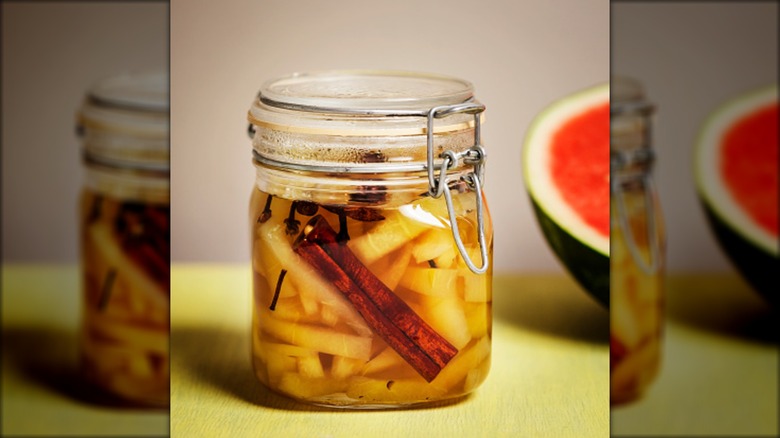
Supermimicry/Getty Images
Pickled cucumbers? There's a jar in most fridges. Pickled jalapeños? Most of us have eaten them on nachos. But pickled watermelon rind? Many people have never even heard of this traditional Southern food that's been around for hundreds of years. One of the oldest recipes is a handwritten one from North Carolina that dates back to 1859.
The practice of pickling likely began as a way to reduce food waste, make use of something that would otherwise be thrown away, and stretch food further. But along the way, it's given us a variety of foods that are delicious, and iconic in their own right. Pickled watermelon rind can be used in salads, sandwiches, burgers, or even to add some zing to cocktails or mocktails.
Pickling watermelon rind involves soaking it in pickling salt overnight to tenderize it, then cooking it, and packing it in a spiced brine. It's not the simplest thing to make, but when done right, it's incredibly good.
Chess pie
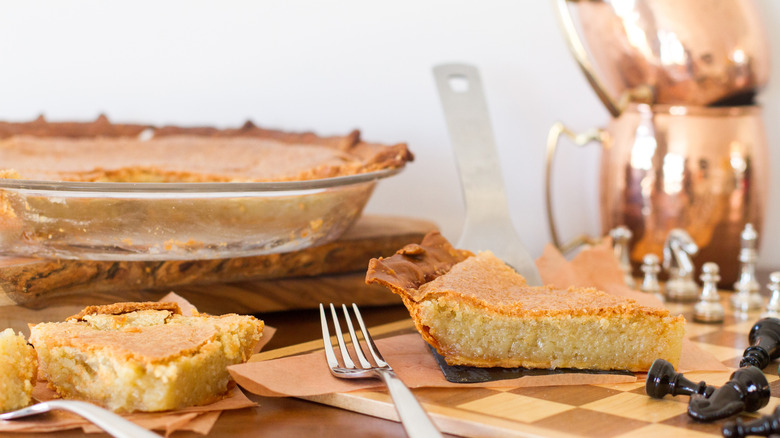
Ginauf/Getty Images
An old-fashioned recipe from the American South, chess pie has fallen out of favor in the modern day. It doesn't have the reach or popularity of pecan pie or sweet potato pie, but it still stands up. It would be a shame to see it lost to time, so we think it deserves a revival.
So, what is chess pie? It's a little bit like a buttermilk pie, or a baked cheesecake, but it's also entirely its own thing. The crust is a standard pastry, and the filling is a sweet mixture of sugar, butter, eggs, evaporated milk, and buttermilk or vinegar. After baking, the pie has a distinctive, almost crème brûlée-like crackle on top. There's a slight tartness from the buttermilk or vinegar, and a creamy texture, which both make chess pie comparable to cheesecake. It's a simple, old-school dessert sure to please a crowd.
Lane cake

Aiselin82/Getty Images
Lane cake has a long but crystal clear history. In the late 1800s, it was invented by Emma Rylander Lane, who entered it into a fair in Georgia, and won first prize. For a while after this, the dessert was known as prize cake, until Lane published her cookbook, "Some Good Things to Eat," in 1898. In the book, she called it Lane cake, and the name stuck.
If you're not familiar with this Southern classic, it consists of layers of white cake (usually at least three) alternated with a boozy bourbon custard filling that's packed with toasted pecans and coconut, raisins, and tart cherries. Sometimes it's frosted with another layer of plain custard. Lane cake is so iconic in the South that it even got name-checked in "To Kill a Mockingbird," but it's becoming less and less common elsewhere. It's not the simplest cake to make, but you won't regret giving it a try.
Benne wafers

Lando Aviles/Shutterstock
Little known outside the Lowcountry of South Carolina, benne wafers are thin, crispy cookies with a sweet caramel note, and the rich nuttiness of benne seeds, brought to the American South from western Africa. The flavor of benne seeds is similar to that of sesame seeds, which is what folks typically use now when they make these cookies. The recipe for traditional benne wafers involves toasting the seeds before baking them in a thin batter, a little like a lace cookie. They come out with a crisp texture and a rich, toasty flavor.
The origin of these cookies comes from the enslaved people who were taken from Africa, and forced to work in plantations in the American South. Some of these people brought with them benne seeds, which they planted, and then used for flavor in their own cooking. Over time, these cookies became a traditional food in the region. But despite their long history, benne wafers are sadly not well known today.
Boiled peanuts
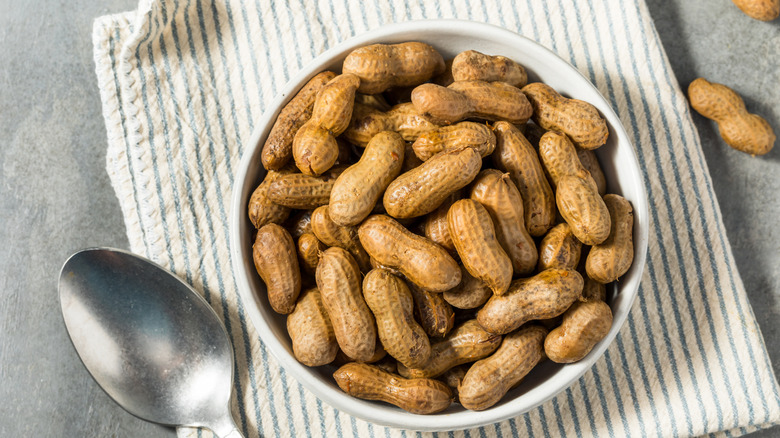
Bhofack2/Getty Images
You might be used to eating roasted peanuts, or popping them out of their shells to enjoy raw. But boiled peanuts are another Southern classic that we don't see enough of these days. The name makes them sound potentially soggy and flavorless, but cooking them in this way makes them anything but. Boiling peanuts is all about adding flavor.
To make this iconic snack, you simply take peanuts in their shells, and boil them in a pot of water with seasonings until they've softened, and soaked up the flavor. You should ideally use green, raw peanuts that haven't been dried or roasted in any way. These need to be kept refrigerated until you're ready to use them.
You can season your boiled peanuts however you'd like. Try Cajun spices, BBQ spices, or salt and vinegar. When they're done, the peanuts will be soft, and packed with flavor inside their shells. The process usually takes around 2 hours, but this can vary depending on your texture preference, and the age or size of the peanuts. Check them after a couple of hours, and keep cooking if they need it.
Beaten biscuits
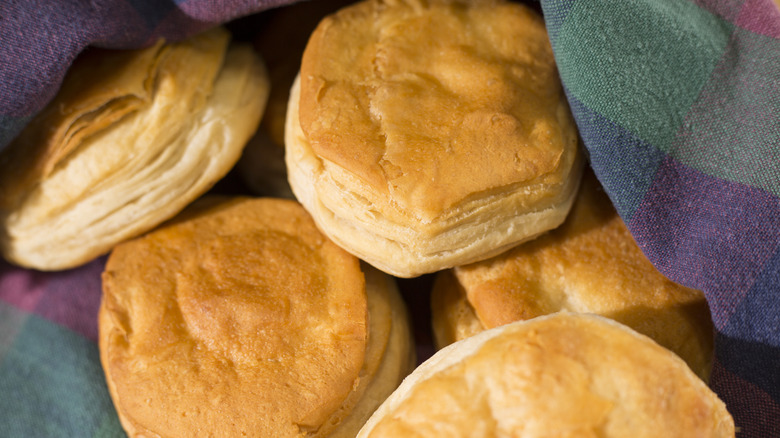
Lifestylevisuals/Getty Images
You'd be right if you said that biscuits haven't fallen off anyone's radar, but you'd probably be talking about the regular, fluffy kind. We're talking about beaten biscuits, a lesser-known version that's markedly different. They've gone in and out of style since the 1800s, and they're currently on the outs, but maybe it's time for a comeback.
The name comes from the fact that the dough is literally beaten with the underside of a skillet, a mallet, or other flat, heavy object. Along with getting beaten, the dough is folded, which creates layers of lamination, making them crisp and flaky. They're not meant to be fluffy like standard biscuits, but they shouldn't be tough, either.
Traditionally, beaten biscuits have been more common in the Upper South, where they're eaten with country ham and gravy. Making them isn't an easy process, which might be why they've fallen out of favor today. At the height of their popularity in the late 1800s, though, there was a machine invented for the express purpose of beating and folding the dough. Perhaps if that made a return to the market, the biscuits would as well.
Tomato pudding
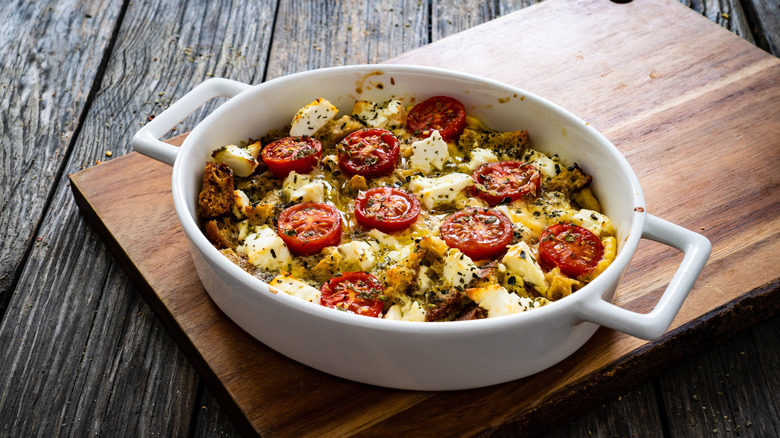
Jacek Chabraszewski/Shutterstock
When you hear the words "tomato pudding," you might think of something like a chocolate pudding or vanilla pudding. But this forgotten Southern dish is more akin to a bread pudding. It's a kind of casserole that was invented back in the 1800s, possibly in Bertie County, North Carolina, to use up big gluts of tomatoes at the end of the season.
Recipes vary slightly, but fresh tomatoes always play a major role. They're combined with either cubed or crumbled white bread or biscuits, sugar, and a range of herbs and spices. All the ingredients are baked in the oven to create an almost custard-like texture. The result usually has a sweet-savory vibe, like a sweet potato casserole. However, some people treat it like a fruity dessert, adding sweet spices like nutmeg, cinnamon, and extra sugar. It can be an acquired taste, which may be why tomato pudding is not as common as it once was, but we think this dish deserves a place in your classic casserole repertoire.
Sorghum syrup
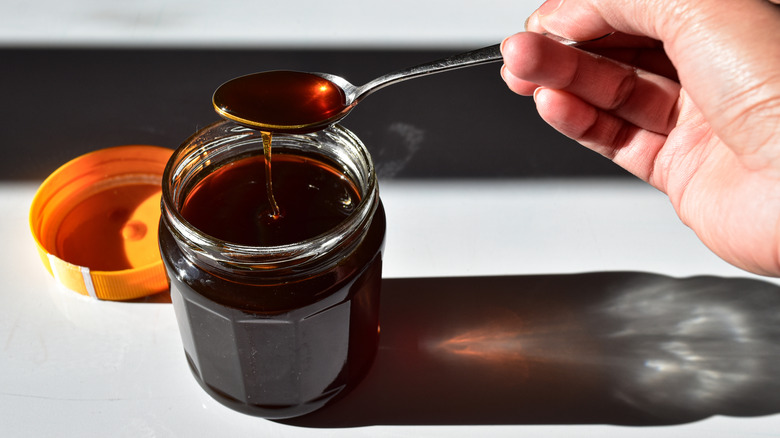
Rena Lolivier/Getty Images
Sorghum syrup is the old-school Southern alternative to maple syrup. If you're wondering what sorghum is, it's a native African plant that was introduced to the American South in the 1800s. While its grains can be cooked or turned into flour, like wheat, the stalks are processed to make a sweet syrup.
You can use sorghum syrup anywhere you might otherwise use maple syrup or honey. Pour it over pancakes or waffles, use it as a liquid sweetener in sauces and marinades, mix it into baked goods, stir it into glazes; the list goes on. While it's obviously sweet, sorghum syrup also has a slight smokiness and earthiness to it. This makes it more complex than many other sweeteners, and allows it to add something special to dishes.
If you want to learn the ways of classic Southern cooking, familiarizing yourself with sorghum syrup is a must. You'll still find it in the pantries of old-school Southern cooks, but we'd love to see it have a wider reach all over the United States.
Ambrosia salad
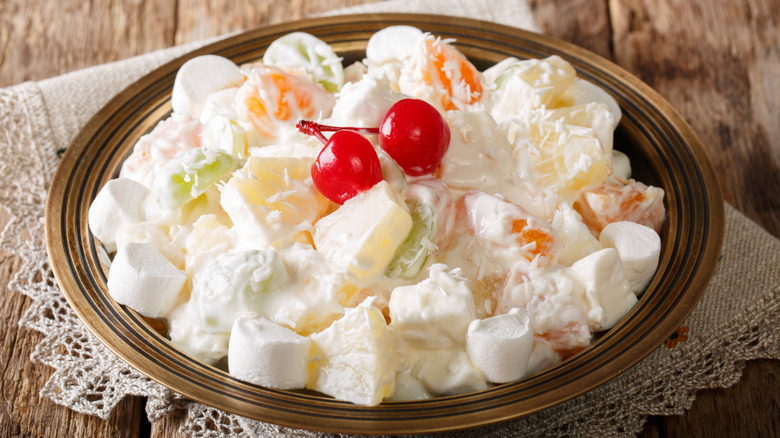
Alleko/Getty Images
Many people have heard of ambrosia salad, but many also regard it as a curiosity from the past. There's a good reason why it's a Southern classic, though: The dish manages to be summery and light, but also indulgent, and it turns canned fruit into a real treat, rather than something you might pick up from a buffet just to have something colorful on your plate.
Ambrosia is a fruit salad that usually consists of diced pineapple, mandarin slices, grapes, and maraschino cherries mixed with Cool Whip. Extra flavor and texture can be added in the form of shredded coconut, pecans, or mini marshmallows. Many recipes also include some sour cream to balance it out, and cut through the sweetness.
Yes, it's retro. There's no denying that. But we believe there's space for ambrosia salad in the 21st century. It's such an iconic part of Southern culinary history that it would be a shame to see it lost to the annals of time. So, let's bring it back, and not let anyone make us feel bad about it.
Cornbread dressing
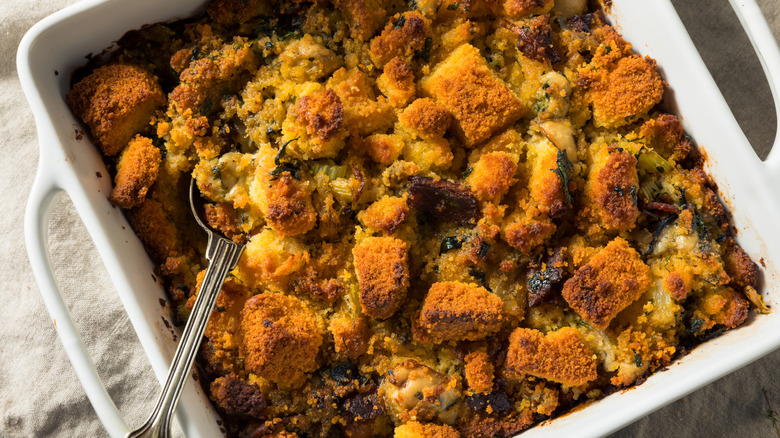
Brent Hofacker/Shutterstock
When Thanksgiving comes around, it's time for stuffing, or dressing. (If you're wondering about the difference, technically, stuffing is cooked inside a turkey, while dressing is baked on its own in a separate dish.) Cornbread dressing is an old Southern classic that deserves to be more popular, and not just around the holidays.
Many families from the South have cornbread dressing recipes that have been passed down through the generations. This means that there's no single right way to make it. If you want to do it all from scratch, though, you have to make the cornbread yourself. If you have access to ready-made cornbread, or if you have leftovers, great. But if not, go ahead and use your favorite Southern-style cornbread recipe, then mix cubes of it with eggs, broth, and aromatics like onion and herbs. Bake it all together to create a moist, flavorful dressing with a Southern flair. It's the kind of dish that always earns its spot on the table.



